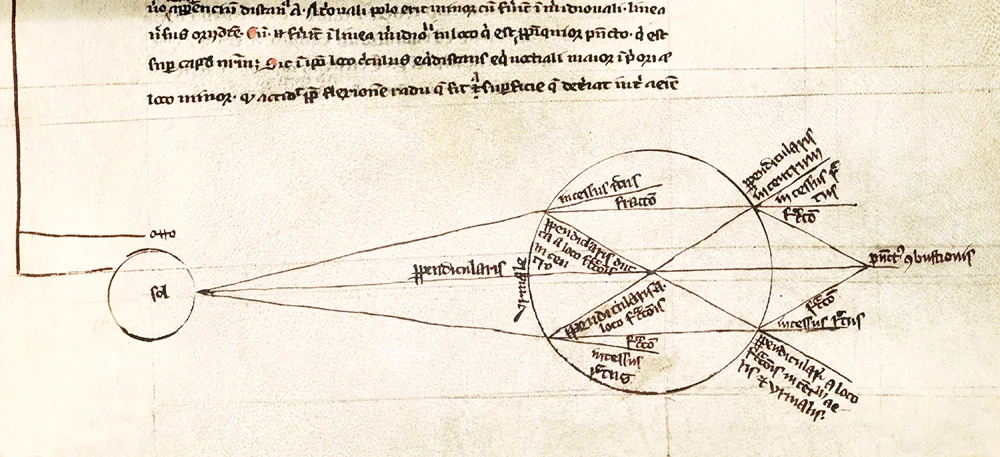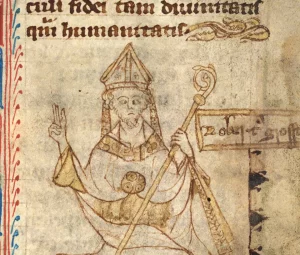
In our series of occasional insight articles highlighting the contribution to the development of optical science by physicists through the ages, we commemorate the anniversary of the death of Robert Grosseteste.
Grosseteste, who died on October 8th or 9th in 1253, was a towering intellect of the thirteenth century. His name may be less familiar than Newton’s or Galileo’s, yet the foundations for the scientific method and the history of optics were laid by this English bishop.
Known as a statesman, philosopher, and scientist, Grosseteste rose to become the first Chancellor of Oxford University and the Bishop of Lincoln from 1235 until his death in 1253. As with other great medieval academics, his work synthesises philosophy, theology and science, unifying these disciplines with a singular, integrated vision of a divinely ordered and rationally intelligible universe.
The Dawn of Experimental Science
Aside from all his other remarkable achievements, Robert Grosseteste was an original thinker, pioneering modern experimental science. Challenging his era’s reliance on ancient authorities, Grosseteste pioneered a sophisticated scientific method, involving a dual process of analysis (resolutio), working backward from an observation to identify its fundamental principles, and synthesis (compositio), using those principles to construct a complete explanation. Crucially, he insisted that any resulting theory must be rigorously tested and verified by real-world experience (experimentum).
For Grosseteste, mathematics – particularly geometry – was the essential language for describing the natural world, famously stating that “all causes of natural effects must be expressed by means of lines, angles and figures”. This conviction led him to deduce that the path of a light beam could be described geometrically, making optics the foundational science and establishing the principles of geometrical optics.
Light as the Fabric of Reality

For Grosseteste, a devout theologian and a pioneering scientist, the opening verses of the Book of Genesis were likely not just a matter of faith, but a subject for scientific inquiry. The declaration, “And God said, let there be light: and there was light,” informs his entire worldview. Central to this was his belief that light, or lux, is the “first form” of all things – the basic building block that gives the physical universe its substance and reality.
This belief in the primacy of light was not merely a philosophical assertion; it was the basis of a comprehensive physical cosmology. His groundbreaking work in optics profoundly influenced the Franciscan school at Oxford, notably his most famous student, Roger Bacon. Bacon’s own work on optics and universal causation was a direct intellectual inheritance from his teacher. Grosseteste’s visionary thinking is vividly captured in his treatise De Iride (On the Rainbow), where he foresaw the principles of magnification that would later lead to the telescope and microscope.
‘This part of optics, when well understood, shows us how we may make things a very long distance off appear as if placed very close, and large near things appear very small, and how we may make small things placed at a distance appear any size we want, so that it may be possible for us to read the smallest letters at incredible distances, or to count sand, or seed, or any sort of minute objects.’
A Universe Born from an Explosion of Light
Building on this worldview, Grosseteste’s works De Luce (On Light) and De Colore (On Colour) display a remarkably modern understanding of the universe. He argued that light was composed of infinitely small particles – a concept that foreshadowed the modern photon.
His description in De Luce of the birth of the universe is astonishingly prescient. It details a primal event where a single, dimensionless point of light instantaneously explodes, infinitely multiplying itself and expanding spherically to create the volume of the material universe. This primordial expansion bearing a metaphorical resemblance to the modern Big Bang theory, was followed by the subsequent crystallisation of this light into matter. In this elegant model, the entire cosmos is governed by the universal and immutable laws of light’s geometric propagation, a postulate that anticipates one of the fundamental ideas of Newton’s theory of gravity: that the same laws of physics apply to the entire universe.
From Medieval Vision to Modern Photonics
Centuries after his death, the foundational principles Robert Grosseteste championed are alive in the design and fabrication of every modern optical component. His assertion that the path of light can be described by “lines, angles and figures” is the very basis of the advanced ray-tracing software used to engineer precision optics for laser systems.
The scientific method of analysis (resolutio), synthesis (compositio), and verification (experimentum) he developed is the blueprint for our work. We begin with the fundamental principles of a customer’s challenge, design a component to solve it, and then fabricate and rigorously test the final optic to ensure its performance. This enduring legacy – a methodical, mathematical, and empirical approach to manipulating light – is what allows us to create the components behind today’s most advanced laser systems. You can read about our capabilities in fabricating optical components, including optical and thin film design on the What We Do page.

